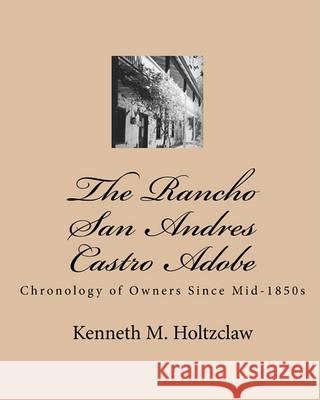The Rancho San Andres Castro Adobe: Chronology of Owners Since Mid-1850s » książka
The Rancho San Andres Castro Adobe: Chronology of Owners Since Mid-1850s
ISBN-13: 9781450575362 / Angielski / Miękka / 2010 / 168 str.
The Rancho San Andres Castro Adobe: Chronology of Owners Since Mid-1850s
ISBN-13: 9781450575362 / Angielski / Miękka / 2010 / 168 str.
(netto: 56,86 VAT: 5%)
Najniższa cena z 30 dni: 60,03
ok. 16-18 dni roboczych
Bez gwarancji dostawy przed świętami
Darmowa dostawa!
Seven adobes once stood in the Pajaro Valley in the Monterey Bay area in 1850, among them those of the Castro, Amesti, Rodriguez, and Vallejo families. All are now gone, with the exception of the two-story Rancho San Andres Castro Adobe, a few miles north of Watsonville, California. The structure has great historical significance because it is the only surviving rancho hacienda of the Mexican Colonial Period. Even the adobe mounds and stone remnants of the other six adobes which remained for awhile are now gone. The chronological presentation given in this book covers a period from the early 1800s to 2009 and is particularly dedicated to the Rancho San Andres Adobe and the owners and inhabitants of this residence. The purpose of this book is to give an account of memories and events associated with this unique hacienda and its owners and inhabitants. By 1823, Jose Joaquin Castro, a member of the Anza party from Mexico, was granted provisional concession from Mexico to the Rancho San Andres, a respectable spread of approximately 4,400 acres, ranging from Monterey Bay to Corralitos, and from the Pajaro River to Aptos. Along with his sons and daughters, their family holdings eventually included the greater part of what is now Santa Cruz County, from Pajaro to Aptos to Soquel, and almost to Davenport to the north, consisting of over 250,000acres. This was an interesting book to research and write, because once I had lived in a house on the grounds of the old Castro Adobe property which included 39 acres, two houses, one which my family lived in, and the Castro Adobe. We lived on this farm during a portion of my childhood. Fond memories of the beautiful adobe structure still linger with me and over time these memories often lured me back to visit the old adobe hacienda. But now many others will enjoy this setting, since it has been bought by the state and will be used as a park.
Zawartość książki może nie spełniać oczekiwań – reklamacje nie obejmują treści, która mogła nie być redakcyjnie ani merytorycznie opracowana.











